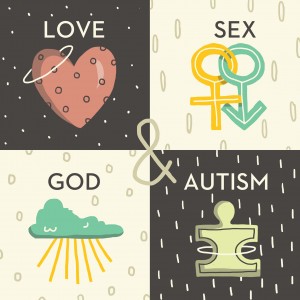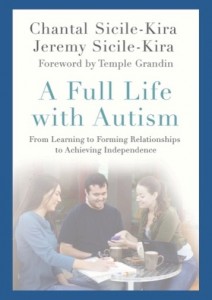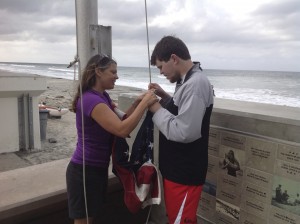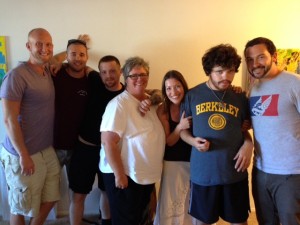Here’s an article contributed a few years ago by Marci Wheeler, MSW From Indiana Institute on Disability and Community. The information is still pertinent today.
Academic Supports for College Students with An Autism Spectrum Disorder: Quick Overview
Each year more information about the college experiences of those on the autism spectrum is written by their parents, professionals and these students on the autism spectrum. “Temple Grandin” a biopic movie of Temple’s life premiered last year on HBO, and won several Emmy and other awards. Included in the film, of this very accomplished woman with autism, is a significant look at Temple’s experience at college. This film also reminds us that fellow college students need information to better understand their peers on the autism spectrum and how to include and support them. There is much more to college life than academics. Intellectually these students are often very bright but many may face a variety of “hidden challenges” that can undermine their ability to navigate a typical college campus and perform well in class. This article will discuss some of the challenges and possible academic supports for students on the autism spectrum.
There is a wide range of functioning and abilities seen across individuals diagnosed with an autism spectrum disorder. Generalities are hard to make except to say that communication and social skills deficits are present. There are also neurological differences that affect everyone on the autism spectrum. However, each person is affected in different ways. The sensory perceptions, motor skills, learning styles and coping strategies are often affected and may cause “hidden” challenges that are not understood by those supporting these students. As a result of these challenges the observable behaviors of students on the autism spectrum may make them appear inattentive, bored, rude, defiant or possibly even on drugs. Ritualistic or repetitive behaviors, an attachment to incongruous objects and additional unusual communication and social skills (especially under stress) can make some of these students seem odd and bring unwanted attention to them.
Some students on the autism spectrum may experience sensory overload and/or be distressed by the social and communication demands of a class. They may have learned “acceptable” strategies to cope and have the ability to stay focused on their intellectual pursuits such that they can navigate through their classes (at least the classes in their chosen major) and pass as “normal”. Some students expend a lot of energy, at all costs, to blend in and not be detected. Unfortunately, for some, this may result in them leaving the university without finishing a degree as the stress is too great. Also, on any college campus be assured that there are students who have not been formally diagnosed or students that are not diagnosed until their college years.
Professors and other instructors need to be aware of possible supports that a student on the autism spectrum might find necessary to participate in class and complete classwork. The following six sections briefly state a common concern for most students and list some possible issues and accommodations. Each student on the autism spectrum has unique needs and should work closely with instructors and other college staff to design an individualized plan of proactive support and response to challenges if they arise.
Communication Skills
By definition (following diagnostic criteria) all students with an autism spectrum disorder have some problems which may interfere with receptive or expressive communication. Some of these differences are very subtle and can lead to misunderstandings that are misinterpreted as volitional acts on the part of the student. Students with an autism spectrum disorder may be very articulate and have a large vocabulary which may “hide” their communication challenges. Those supporting students on the autism spectrum should become aware of each individual students weaknesses in this area. Some of these are listed below along with possible accommodations.
Receptive difficulties often experienced by students on the autism spectrum include processing verbal exchanges more slowly, misunderstanding sarcasm, idioms and jokes, very literal interpretation of words, and misunderstanding gestures and body language.
The expressive difficulties of individuals on the autism spectrum may include problems initiating communication; even for those students who at first glance may seem very articulate and even very talkative. Those on the autism spectrum may have trouble staying on topic, turn taking and following conversational “protocol”. Some may be slower to organize thoughts and speak, and/or their voice tone and volume may be unusual. Idiosyncratic use of words and phrases may be present.
Accommodations for a college student with an autism spectrum disorder might include providing the instructor’s lecture notes or a note taker to help key in on important information, providing study guides for tests, allowing a longer verbal response time from the student and allowing for important exchanges of information to be done in written form. It would also help for instructors to be clear, concise, concrete and logical when communicating as well as asking for clarification; don’t make assumptions about what students truly understand.
Social Skills
Social skills might not seem important in a class setting, but, in fact social difficulties can and do impact the classwork of many students on the autism spectrum. Many college courses require class participation and group work as part of earning a grade. Just going to class with peers necessitates the use of social skills. Some social difficulties and possible accommodations are discussed below.
The social challenges for a student on the autism spectrum include problems understanding others perspectives, sharing space and making eye contact. Many high functioning individuals with an autism spectrum disorder have extreme social anxiety and have difficulty negotiating with others, and interacting and working in pairs or groups. These students likely will not understand the “unwritten” classroom etiquette and will often misinterpret facial expressions and other non-verbal cues. Possible accommodations for students on the autism spectrum include allowing for short breaks to leave class and/or allowing the student to have a “social buffering” object which might include a computer, book or other object that initially might seem distracting or “out of place”. Honoring the student’s chosen level of eye contact w/o judgment can be helpful. If there is group work assigned for class the instructor might assist in the formation and monitoring of pairs or groups of students to assure the proper inclusion of the student with an autism spectrum diagnosis. Also providing written rules for asking questions and other classroom logistics (as needed) may support students with an autism spectrum disorder diagnosis.
Sensory Differences
Though currently sensory issues are not part of the diagnostic criteria for an autism spectrum disorder, sensory processing issues seem to affect the majority of these individuals. Some on the autism spectrum have an extreme over sensitivity or under sensitivity to input, from the environment to the five senses: sight, hearing, touch, smell and taste. A significant number of persons experience synesthesia. Synesthesia may affect any of the senses. Synesthesia is phenomena in which the actual information of one sense is accompanied by a perception in another sense. Listed below are some common sensory differences and accommodations that may be important in a class setting.
Common visual and auditory sensory difficulties experienced by students on the autism spectrum include florescent lights that may appear to flicker and certain “bright” colors that may produce “overload”. Someone may see better from a “different” angle or may hear low level frequency sounds emitted by florescent lights. Also certain “typical” classroom sounds may be perceived as “painful” such as the movement and use of desks, people and other objects in the room. Often a person on the autism spectrum may not filter out extraneous sounds and/or may hear sounds in the next room.
Sensory issues related to the sense of touch and/or the sense of smell may occur. For example, certain textures may be “painful” and/or individuals may crave certain textures. Students on the autism spectrum may be disturbed by people accidentally bumping them or the feel of a particular desk or chair. They may wear “unusual” clothing, footwear or accessories because of sensory differences. Also students may be sensitive to certain odors and certain smells may cause “overload”. Some who are very sensitive may be affected by scents from certain perfumes, deodorants and soaps.
Possible accommodations to support a student with sensory differences include allowing hats, sunglasses and tinted lens glasses to be worn and allowing ear plugs or ear phones. Also allowing the student to choose their seat and helping to assure it is always available may be important. If requested by the student, an alternative writing instrument for tests and assignments and/or a computer for in class work, tests and assignments might also be an appropriate accommodation.
A student with an autism spectrum diagnosis may find that a small sensory item brings comfort in class. It is likely, if a student uses a sensory item, that it is inconspicuous but this may not always be the case. Be aware that a student may make a last minute request for a seating change and/or to leave abruptly due to sensory overload. Help devise an acceptable plan to address urgent sensory issues for the student.
Motor Skills
Both fine and gross motor skills may be affected in individuals with an autism spectrum disorder. In addition motor planning and poor awareness of body in space are two areas that often affect motor skills for these individuals. Often fine and gross motor skills as well as motor planning skills are very uneven. Listed below are possible problems in these areas along with possible accommodations.
Fine motor challenges for students on the autism spectrum might affect writing, drawing, turning pages, using utensils, playing an instrument, using locks and keys, and manipulating small objects. Gross motor challenges may affect walking (may have “odd” gait), running, sitting and balancing. Motor planning and the awareness of the placement of their body in space can affect the ways in which an individual moves their body and is able to navigate themselves to accomplish all motor tasks.
Possible accommodations for students on the autism spectrum with motor skills difficulties include allowing a computer for in class work, tests and assignments, providing a note taker, allowing work assignments done at a slower pace, providing models and step by step instruction, providing extra time to take tests and providing readers and scribes (or technology that reads and takes notes). Further accommodations might need to be considered for students taking physical education courses in which motor skills differences might provide further complications.
Learning Style
Students with an autism spectrum disorder often have a very uneven learning profile. They often excel creatively in a non-conventional way. Students on the autism spectrum tend to have excellent long term and rote memory abilities. Executive functioning deficits cause these students many problems. Many are thought to be right-brained thinkers. Most need to like and trust an instructor before they can perform in a class. Some common learning challenges, strengths and possible accommodations are listed below.
Executive function challenges experienced by students with an autism spectrum diagnosis include general organization and planning skills, problems with impulsivity and problem solving and the ability to monitor themselves in the completion of a goal.
Along with the executive functioning deficits, common learning barriers include poor sequential learning, easily bored with repetition once something is learned, attention problems, literal thinking, nebulous sense of time and as mentioned previously, perspective taking deficits. Other issues that impacts learning for students on the autism spectrum are the fact that they need to understand why something is important, relevant or meaningful to them and they may not realize they are having academic difficulty until it may be too late or too difficult for them to rectify on their own.
The strengths of students on the autism spectrum can sometimes help them compensate for their weaknesses. These students can do quite well academically, especially in their chosen field, and their strengths should be respected and used whenever possible. For example these students may have extremely good visual and visual-spatial skills. They often learn best from whole to part (complex to simple) and they can be very creative; out of the box thinkers. These students can also show an amazing knowledge on topics of interest which is most often their major field of study at the university.
Possible accommodations for students on the autism spectrum to support their learning style include providing review sheets, work checklists, and “sub” deadlines and/or intermittent “check-ins.” If possible provide hands on learning, models, demonstrations and other visuals. If possible, pair with peer mentors who might help with feedback and provide “proof-read” opportunities and ongoing structure to keeping on target with work assignments.
Instructors can help support students on the autism spectrum by providing reinforcement at every opportunity. Other accommodations that might be helpful for some students are allowing advanced negotiation of deadlines, extra time for tests, and/or a separate “quiet” place for tests.
Instructors and other college staff can also encourage the use of calendars (computer, traditional, phone w/alarms). Most likely the student has experience with using an organizational tool or tools, of choice, before coming to college. However, sometimes in a new environment the tools and skills used and learned to compensate for executive function deficits do not transfer easily to a new setting. Because the setting has changed, the student may need time “extra” transition time to begin the use of these tools and to maintain routines in the new environment.
Coping Skills
Individuals with an autism spectrum disorder frequently describe themselves as dealing with a lot of anxiety and stress. Sensory sensitivities, social and communication expectations as well as transitions and unexpected changes often trigger this anxiety and stress. It is during these times when these students may display behavior that can seem bewildering, rude or disruptive. Most often when a student displays these behaviors they are doing what they know to do to cope. In fact, these sometimes “confusing” behaviors are often experienced as calming. Included below are examples of coping behaviors in which students with an autism spectrum disorder may engage and possible accommodations.
When under stress, students on the autism spectrum may engage in stress relieving activities which look odd and may even make others feel uncomfortable. These activities may include body rocking, pacing, waving or flapping hands or fingers repetitively, chewing on their clothing or body, “lecturing” on a topic of interest or they may display the “opposite” emotion for the situation. They also may abruptly leave the situation with no explanation before or afterwards.
A possible accommodation in helping the student cope, in the moment, might be to discretely ask the student if something is overwhelming and/or ask if the student needs help or wants to leave. Do not discourage or interrupt behavior unless truly disruptive and understand that student does not intend to be disrespectful. Allow sensory items and/or other “comfort” objects. A student, who is having a hard time coping, might not realize when s/he is being disruptive and needs to leave. The instructor and student can agree on a cue that the instructor can give to signal to the student that it is okay/time to leave. They can also agree on a signal, to inform the instructor when the student is overwhelmed or confused.
Ideally, preparing young adults with an autism spectrum disorder for the demands of college has started years earlier. With a proper diagnosis, individualized early intervention and careful transition planning, college students with an autism spectrum diagnosis, will be better prepared to advocate for themselves. At the same time college professors and other staff at post-secondary colleges and universities need to be prepared for students on the spectrum who are seeking to be a part of these institutions in greater and greater numbers. These students must be given reasonable accommodations to provide an equal opportunity for pursuing a college education. Many great minds and opportunities for society could be lost if individuals on the autism spectrum are not supported in their post-secondary academic pursuits.
Note:
The information in this article is based on Marci Wheeler’s work at the Indiana Resource Center for Autism, Indiana Institute on Disability and Community at Indiana University-Bloomington; including her role as Advisor for the Students on the Spectrum Club at Indiana University – Bloomington.
If you need more information about supporting students on the autism spectrum in a university/college setting, please contact your local autism organization or campus office for students with disabilities to find out who can assist. Indiana residents can contact Marci Wheeler at mwheeler@indiana.edu or phone (812) 855-6508.
With Special Thanks to the members of the Students on the Spectrum Club at Indiana University – Bloomington for sharing their insights as they navigate the college setting.
Resources
Attwood, T. (2007). The complete guide to Asperger’s Syndrome. Philadelphia: Jessica Kingsley Publishers.
Harpur, J., Lawler, M. & Fitzgerald, M. (2004). Succeeding in college with Asperger Syndrome: A studentguide. Philadelphia: Jessica Kingsley Publishers.
Palmer, A. (2006). Realizing the college dream with autism or Asperger Syndrome: A parent’s guide to student success. Philadelphia: Jessica Kingsley Publishers.
Prince-Hughes, D. (2002). Aquamarine Blue 5: Personal Stories of College Students with Autism. Athens, OH: Ohio University Press.
Wolf, L.E., Brown, J.T,. Bork, G. R. K. (2009). Students with Asperger Syndrome: A guide for College personnel. Shawnee Mission, KS: Autism Asperger Publishing Company.










